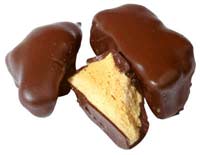巧克力作為世界上最風(fēng)靡的食品之一,被賦予了種種意義。現(xiàn)在大家接觸巧克力最多的場(chǎng)合當(dāng)屬“情人節(jié)”前男女雙方為對(duì)方購(gòu)買(mǎi)包裝精美的巧克力作為禮物。可是當(dāng)你美滋滋地在品嘗情人送的巧克力時(shí),你可想到過(guò)它的發(fā)明者和由來(lái)?
American-made chocolate and cocoa(可可) products number in the hundreds. There is a fascinating(迷人的)story behind these wonderful products.
The story of chocolate, as far back as we know it, begins with the discovery of America. Until 1492, the Old World(指歐洲大陸,相對(duì)于美洲大陸)knew nothing at all about the delicious and stimulating flavor(富有刺激性的口味) that was to become the favorite of millions.
The Court of King Ferdinand and Queen Isabella got its first look at the principal ingredient(調(diào)料、原料)of chocolate when Columbus returned in triumph from America and laid before the Spanish throne(王位)a treasure trove of many strange and wonderful things. Among these were a few dark brown beans(豆)that looked like almonds(杏仁)and seemed most unpromising(無(wú)指望的). They were cocoa beans, today's source of all our chocolate and cocoa.
The King and Queen never dreamed how important cocoa beans could be, and it remained for Hernando Cortez(科爾特斯), the great Spanish explorer, to grasp(把握住)the commercial possibilities of the New World offerings.

During his conquest of Mexico, Cortez found the Aztec Indians(阿茲特克印第安人)using cocoa beans in the preparation of the royal drink of the realm, "chocolate," meaning warm liquid. In 1519, Emperor Montezuma, who reportedly drank 50 or more portions daily, served(提供,招待) chocolate to his Spanish guests in great golden goblets(高腳杯), treating it like a food for the gods.
For all its regal(王室的) importance, however, Montezuma's chocolate was very bitter(苦), and the Spaniards did not find it to their taste. To make the concoction(調(diào)制品) more agreeable to Europeans, Cortez and his countrymen conceived the idea of sweetening it with cane sugar.
The new drink quickly won friends, especially among the Spanish aristocracy(貴族). Spain wisely proceeded to plant cacao in its overseas colonies, which gave birth to a very profitable(利潤(rùn)高的) business. Remarkably enough, the Spanish succeeded in keeping the art of the cocoa industry a secret from the rest of Europe for nearly a hundred years.
During World War II, the US government recognized chocolate's role in the nourishment(營(yíng)養(yǎng)品)and group spirit(士氣、團(tuán)隊(duì)精神) of the Allied Armed Forces, so much so that(到這樣的程度以至于)it allocated valuable shipping space(分配寶貴的船艙空間)for the importation(運(yùn)輸) of cocoa beans. Many soldiers were thankful for the pocket chocolate bars(塊、條) which gave them the strength to carry on until more food rations(配給)could be obtained. Today, the US Army D-rations(美國(guó)陸軍D類配給食品) include three 4-ounce chocolate bars(4盎司巧克力塊)late has even been taken into space as part of the diet(食品供應(yīng)、食譜)astronauts(宇航員).
(英語(yǔ)點(diǎn)津Jennifer編輯)
相關(guān)閱讀:
中英早餐比比看
男生英語(yǔ)學(xué)不好 全怪班里女生多?
“會(huì)飛”的照相機(jī)和相片
豬流感常識(shí)早知道